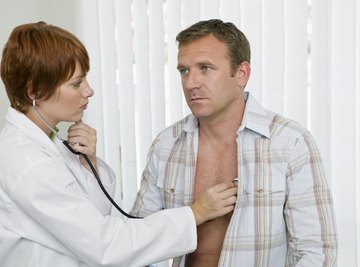
The human body that represents your physical life form has a great many tasks to perform in order to keep its owner alive and operational. At each moment, your heart and lungs are working, and a variety of other things are occurring inside you, even as you sleep. Some of these you can feel but not control, such as digestion; others will forever elude your conscious detection.
It is convenient to divide the many components of the body into systems based mainly on function. In some instances, this scheme makes body systems well localized; in others, they are anatomically dispersed throughout the body. Today, most primary sources offer a total of 11 body systems and functions, described in brief detail below.
Body Systems and Functions
As you have probably already concluded, the different human body systems have a vast array of overlapping and complementary functions. The sympathetic and parasympathetic control of heart rate is an example of the nervous system function interacting with the circulatory system. (The parasympathetic effect on heart rate is to slow it; sympathetic input accelerates it.)
The Circulatory System: Also called the cardiovascular system, the heart and blood vessels have the job of delivering oxygen and nutrients to the rest of the body and collecting waste products for removal from the body by other systems.
The Respiratory System: Your lungs allow you to inhale and exhale air to exchange gases between blood and lung space deep within the lungs themselves. The carbon dioxide produced in metabolism is "off-loaded," while oxygen from air is "on-loaded" to red blood cells.
The Skeletal System: Your bones, cartilage and ligaments provide a structural framework for the rest of you, like a scaffolding for organs and tissues. This system affords protection of vital organs and permits locomotion of the organism; the bone marrow in the middle of long bones makes immune cells.
The Muscular System: Muscles comes in three main types. Skeletal muscles move you around and perform other functions when you contract them voluntarily. Smooth muscle lines organs such as the gut and bladder and operates involuntarily. Cardiac muscle is a specialized kind of muscle in the myocardium of the heart.
The Integumentary System: This includes the skin, hair and nails, mostly the former. This physical barrier helps keep out microorganisms, regulates the moisture level of the organism and keeps temperature steady. The skin and other parts of the integumentary system work hand-in-hand with the body's immune system, such as keeping out germs and bacteria. Sometimes the immune system is listed separately from the integumentary system, leading to 12 body systems and functions rather than 11.
The Digestive System: This system converts ingested foods into smaller molecules your cells can harvest energy from.
The Nervous System: Your brain, spinal cord and a great many peripheral nerves make up this system, which is responsible for collecting, processing and transmitting information.
The Endocrine System: When you hear the word "hormones," think "endocrine system." This system regulates the internal environment of the organism via the dispersal of chemicals (hormones) that act at certain receptors throughout the body. The pancreas, pituitary gland and thyroid gland are part of this system,
The Excretory/Urinary System: Your kidneys help eliminate waste by filtering the blood, keep the acid-base levels of the blood steady, and regulate the amount of blood in the body via electrolyte and other solute balance.
The Lymphatic System: The structures in this system of channels are akin to a second circulatory system, which also includes the spleen, make cells that combat foreign invaders and help return tissue fluid to the blood vessels.
The Reproductive System: This system is responsible for creating gametes, or sex cells (testes in males, ovaries in females) that participate in fertilization and propagation of genes into the next generation of organisms. It includes the uterus in females and external genitalia regardless of sex.
References
About the Author
Kevin Beck holds a bachelor's degree in physics with minors in math and chemistry from the University of Vermont. Formerly with ScienceBlogs.com and the editor of "Run Strong," he has written for Runner's World, Men's Fitness, Competitor, and a variety of other publications. More about Kevin and links to his professional work can be found at www.kemibe.com.
Photo Credits
Jupiterimages/Goodshoot/Getty Images
